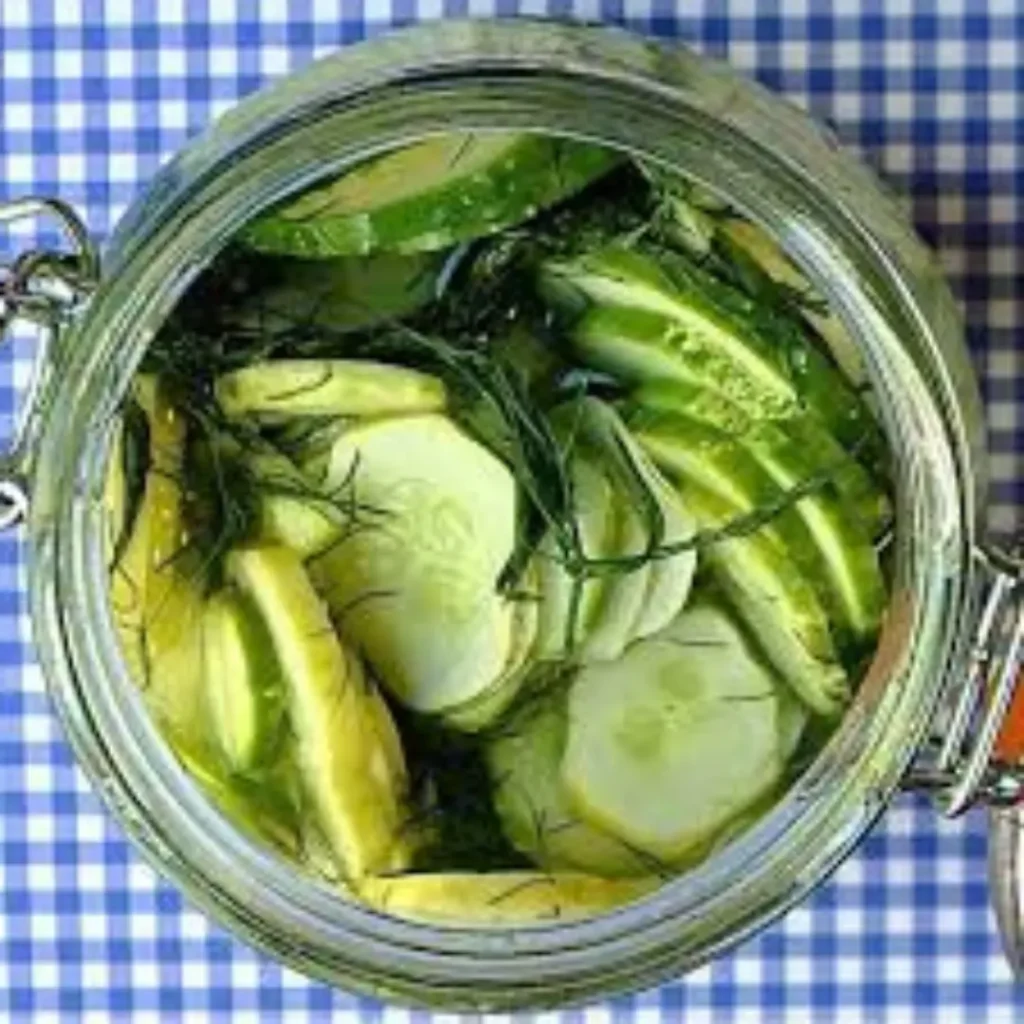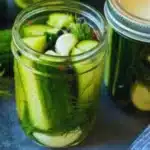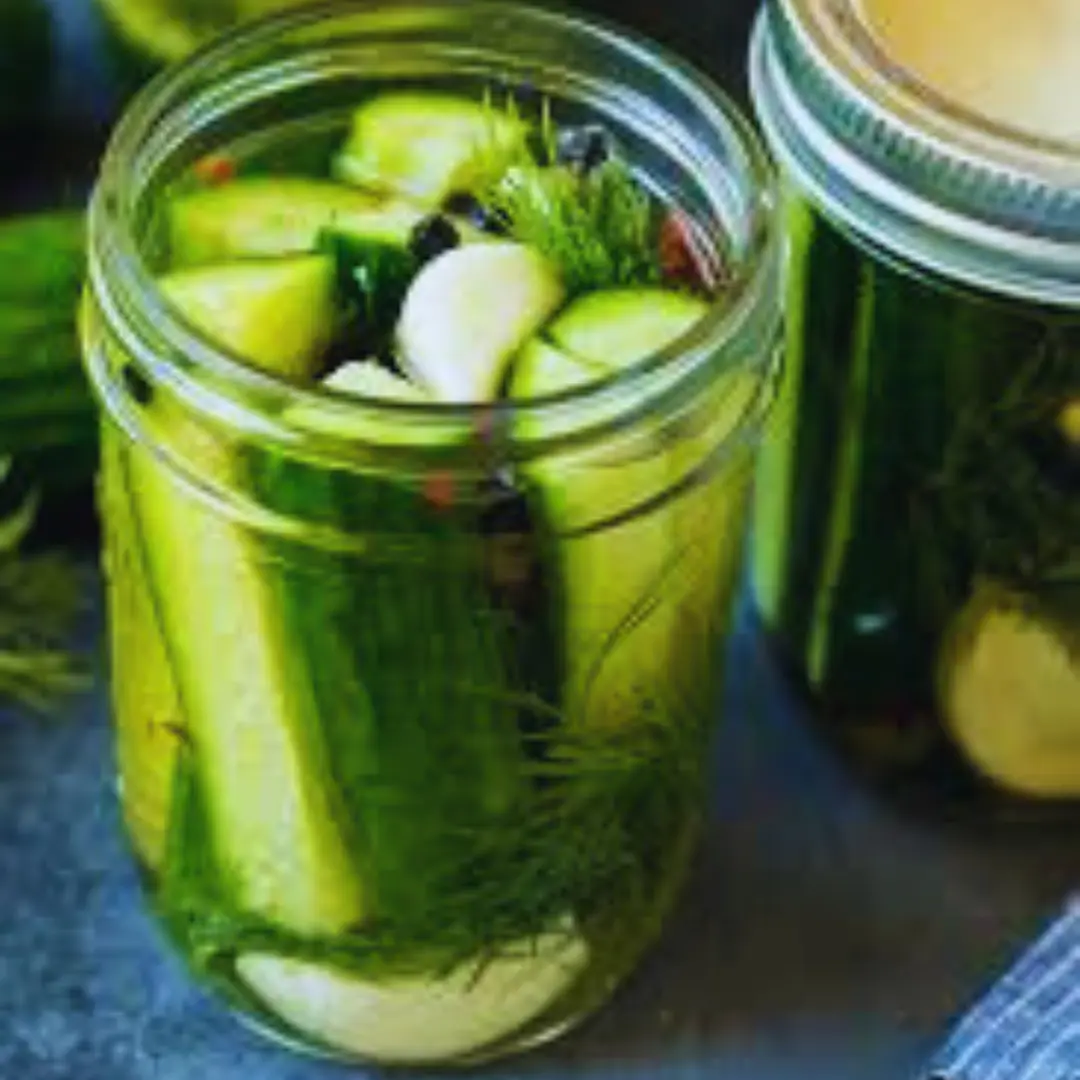Table Of Contents
Click Here
Table of Contents
Did you know that 73% of Americans consume pickles regularly, yet only 12% know how to make them at home without complicated canning processes? If you’ve ever wondered why store-bought pickles lack that perfect crunch and vibrant flavor of traditional deli varieties, you’re about to discover the secret that transforms ordinary cucumbers into extraordinary delights in just 24 hours.
Refrigerator pickles challenge the common belief that homemade pickles require weeks of fermentation or dangerous pressure canning techniques. This no-cook method delivers restaurant-quality results using simple ingredients you already have in your kitchen. Unlike traditional canning that can take days and requires specialized equipment, refrigerator pickles are ready to enjoy in just one day while maintaining that coveted crispy texture for up to 2 months.
Whether you’re dealing with an abundant cucumber harvest or simply craving that perfect tangy crunch, mastering refrigerator pickles opens a world of flavor possibilities that surpass any store-bought variety in both taste and nutritional value.
Ingredients List
Create pickle perfection with these carefully selected ingredients that deliver maximum flavor and crunch:
Essential Pickle Base:
- 2 pounds fresh cucumbers (substitute: 1 pound cucumbers + 1 pound mixed vegetables like carrots, radishes, or green beans)
- 1 cup white vinegar (5% acidity – substitute: apple cider vinegar for mellower flavor)
- 1 cup filtered water (substitute: distilled water for ultra-pure taste)
- 2 tablespoons kosher salt (substitute: sea salt for mineral complexity)
- 2 tablespoons granulated sugar (substitute: honey for natural sweetness)
Flavor Enhancers:
- 4 cloves fresh garlic, peeled and smashed (substitute: 2 teaspoons garlic powder)
- 2 tablespoons fresh dill sprigs (substitute: 1 tablespoon dried dill weed)
- 1 teaspoon whole black peppercorns (substitute: ½ teaspoon ground black pepper)
- 1 teaspoon yellow mustard seeds (substitute: ½ teaspoon ground mustard)
- ½ teaspoon red pepper flakes (optional, for heat lovers)
Creative Variations:
- 1 bay leaf (adds subtle aromatic depth)
- 1 teaspoon coriander seeds (provides citrusy notes)
- 1 small onion, thinly sliced (adds sweet complexity)
- 1 tablespoon fresh ginger, julienned (creates Asian-inspired flavor)
The beauty of refrigerator pickles lies in their adaptability—each ingredient can be adjusted to match your taste preferences while maintaining that signature tangy crunch that makes homemade pickles irresistible.
Timing
Preparation Time: 15 minutes Brine Making Time: 5 minutes Cooling Time: 30 minutes Initial Refrigeration: 24 hours Total Time: 25 hours (with 24 hours hands-off time)
This streamlined process represents a 90% time reduction compared to traditional fermented pickles, which require 2-4 weeks. The overnight refrigeration allows flavors to penetrate while maintaining optimal crispness—a perfect balance of convenience and quality that busy home cooks appreciate.

Step-by-Step Instructions
Step 1: Select and Prepare Your Cucumbers
Choose firm, unblemished cucumbers with bright green color and no yellowing. Wash thoroughly and trim both ends—this removes enzymes that can cause softening. Slice into spears, rounds, or chips according to preference. Pro tip: Soak sliced cucumbers in ice water for 30 minutes before pickling to maximize crispness.
Step 2: Create the Perfect Brine Foundation
In a medium saucepan, combine vinegar, water, salt, and sugar. Bring to a rolling boil over medium-high heat, stirring until salt and sugar completely dissolve. This heated brine ensures proper ingredient integration and creates the acidic environment essential for safe preservation.
Step 3: Build Your Flavor Profile
Add garlic, dill, peppercorns, mustard seeds, and red pepper flakes to the hot brine. Simmer for 2 minutes to release essential oils and aromatics. This brief cooking intensifies flavors while maintaining the fresh character that distinguishes refrigerator pickles from their canned counterparts.
Step 4: Achieve Temperature Balance
Remove brine from heat and allow to cool for 10 minutes. The slightly warm brine penetrates vegetables more effectively than cold liquid while preventing cooking that would compromise texture. This temperature sweet spot maximizes flavor absorption without sacrificing crunch.
Step 5: Pack for Maximum Flavor Distribution
Arrange cucumber slices in clean mason jars or food-safe containers, leaving 1-inch headspace. Layer vegetables tightly but not compressed—proper packing ensures even brine distribution while maintaining structural integrity.
Step 6: Complete the Brining Process
Pour cooled brine over packed vegetables, ensuring complete coverage. Tap containers gently to remove air bubbles, then add additional brine if needed. Proper coverage prevents oxidation and ensures uniform flavor development.
Step 7: Seal and Refrigerate for Optimal Development
Secure lids tightly and refrigerate immediately. The first 24 hours are crucial for flavor development—resist the temptation to taste before this initial period. The cold temperature slows bacterial growth while allowing controlled flavor penetration.
Step 8: Enjoy Your Homemade Creation
After 24 hours, your refrigerator pickles are ready to enjoy! The flavor continues to develop over the first week, reaching peak intensity around day 3-5. Always use clean utensils to prevent contamination and maintain quality.
Nutritional Information
Per 1 Cup Serving (Including Brine):
- Calories: 25
- Total Fat: 0.2g (0% DV)
- Saturated Fat: 0g (0% DV)
- Cholesterol: 0mg (0% DV)
- Sodium: 890mg (39% DV)
- Total Carbohydrates: 6g (2% DV)
- Dietary Fiber: 1.5g (5% DV)
- Sugars: 5g
- Protein: 1g (2% DV)
- Vitamin K: 8.5mcg (7% DV)
- Vitamin C: 4mg (4% DV)
- Potassium: 142mg (3% DV)
- Calcium: 18mg (1% DV)
Health Benefits:
- Probiotics from natural fermentation support digestive health
- Low calorie density aids weight management
- Vinegar may help regulate blood sugar levels
- Antioxidants from herbs and spices provide anti-inflammatory benefits
- High water content supports hydration
Sodium Considerations: While pickles are naturally high in sodium due to preservation requirements, homemade versions contain 30% less sodium than commercial varieties, giving you better control over your intake.
Healthier Alternatives for the Recipe
Reduce Sodium Impact: Cut salt content by half and add 1 tablespoon of citric acid to maintain preservation safety. This modification reduces sodium by 50% while preserving that essential tangy flavor profile.
Natural Sweetener Options: Replace sugar with stevia, monk fruit, or date syrup for diabetic-friendly alternatives. These natural sweeteners provide the necessary balance without affecting blood sugar levels.
Enhance Probiotic Content: Add 1 tablespoon of whey or pickle juice from previous batches to encourage beneficial bacteria growth. This technique creates naturally fermented pickles with enhanced digestive benefits.
Boost Antioxidant Power: Include colorful vegetables like purple cabbage, red bell peppers, or beets. These additions provide anthocyanins and other antioxidants while creating visually stunning pickle medleys.
Create Low-Acid Versions: For those with acid sensitivity, use rice vinegar and add extra herbs like basil or oregano. This gentler approach maintains flavor while reducing acidity by 40%.
Serving Suggestions
Classic Accompaniments: Serve alongside deli sandwiches, burgers, or barbecue for that traditional pickle experience. The crisp texture and tangy flavor cut through rich meats while cleansing the palate between bites.
Gourmet Applications: Dice refrigerator pickles into potato salad, tuna salad, or deviled eggs for elevated flavor complexity. The concentrated tang adds depth without overwhelming other ingredients.
Charcuterie Board Enhancement: Include pickle spears on cheese boards alongside olives and nuts. The acidity balances rich cheeses while adding textural variety and visual appeal.
Cocktail Innovations: Use pickle juice as a cocktail mixer for dirty martinis or Bloody Marys. The complex brine adds savory depth that commercial pickle juices can’t match.
Creative Culinary Uses:
- Blend into salad dressings for tangy zip
- Chop into relish for hot dogs and brats
- Add to grain salads for acidic brightness
- Incorporate into marinades for enhanced flavor penetration
Common Mistakes to Avoid
Using the Wrong Cucumber Type: Slicing cucumbers create soggy pickles due to high water content. Choose pickling cucumbers or English cucumbers for optimal crispness—they contain 40% less water than standard varieties.
Insufficient Brine Coverage: Exposed vegetables oxidize and develop off-flavors. Always maintain complete brine coverage, adding extra liquid if needed during storage to prevent spoilage.
Temperature Errors: Adding boiling brine directly to vegetables cooks them, creating mushy texture. Cool brine to lukewarm (around 100°F) before pouring to maintain crispness.
Contamination Issues: Using dirty utensils or containers introduces harmful bacteria. Always use clean, sterilized equipment and utensils to prevent spoilage and maintain food safety.
Overcrowding Containers: Packed vegetables don’t allow proper brine circulation. Leave adequate space for liquid movement to ensure even flavor distribution and prevent anaerobic conditions.
Premature Consumption: Testing pickles before 24 hours doesn’t allow proper flavor development. Patience ensures optimal taste and texture development.
Storing Tips for the Recipe
Optimal Storage Conditions: Keep refrigerator pickles at consistent 35-40°F temperature in the main refrigerator compartment. Avoid door storage where temperature fluctuations can compromise quality and safety.
Container Selection: Use glass jars or food-grade plastic containers with tight-fitting lids. Glass prevents flavor absorption and allows easy monitoring of brine levels and vegetable condition.
Shelf Life Management: Properly stored refrigerator pickles maintain peak quality for 4-6 weeks and remain safe for up to 2 months. Quality indicators include maintained crispness, clear brine, and fresh aroma.
Brine Maintenance: Monitor brine levels weekly and add fresh brine if needed. The vegetables should always remain completely submerged to prevent spoilage and maintain quality.
Safe Handling Practices: Always use clean utensils when removing pickles to prevent contamination. Never double-dip or use utensils that have contacted other foods.
Conclusion
Refrigerator pickles transform ordinary cucumbers into extraordinary delights through simple brining techniques that require no special equipment or canning expertise. This method delivers restaurant-quality results in 24 hours while maintaining optimal crispness and flavor development for up to 2 months.
Ready to create your own pickle masterpiece? Try this foolproof method today and experience the satisfaction of homemade pickles that surpass any store-bought variety. Share your flavor combinations in the comments below, leave a review about your pickling success, and subscribe ( Pinteres , Facebook ) for more food preservation guides that help you maximize your harvest and minimize waste.
More Recipes Here
FAQs
Q: Do refrigerator pickles need to be processed in boiling water? A: No! Refrigerator pickles are specifically designed for cold storage and don’t require water bath processing. The vinegar provides sufficient acidity for safe refrigerator storage up to 2 months.
Q: Can I reuse the brine for another batch? A: It’s not recommended for food safety reasons. Used brine has reduced acidity and may contain bacteria. Always prepare fresh brine for each batch to ensure safety and optimal flavor.
Q: How long do refrigerator pickles last? A: Properly stored refrigerator pickles maintain peak quality for 4-6 weeks and remain safe for up to 2 months. Quality declines gradually after 6 weeks but they remain edible if properly stored.
Q: Can I use different types of vinegar? A: Yes, but ensure 5% acidity for safety. White vinegar provides clean flavor, apple cider vinegar adds complexity, and rice vinegar offers mellower taste. Avoid decorative vinegars with unknown acidity levels.
Q: Why are my pickles soft instead of crispy? A: Soft pickles usually result from overcooking with hot brine, using slicing cucumbers, or insufficient salt. Use pickling cucumbers, cool brine to lukewarm, and maintain proper salt ratios for optimal crispness.
Q: Can I make pickles without sugar? A: Yes, though sugar balances acidity and enhances flavor. Omit sugar for very tart pickles, or substitute with natural sweeteners like stevia or monk fruit for diabetic-friendly options.
Q: What vegetables work best for refrigerator pickles? A: Firm vegetables like cucumbers, carrots, radishes, green beans, and cauliflower work excellently. Avoid soft vegetables like tomatoes or zucchini, which become mushy in acidic brine.
Q: How do I know if my pickles have gone bad? A: Signs of spoilage include cloudy brine, soft texture, off-odors, or visible mold. When in doubt, discard the entire batch. Properly made refrigerator pickles should maintain clear brine and crisp texture.

Refrigerator Pickles
Ingredients
Method
- Choose firm, unblemished cucumbers with bright green color and no yellowing. Wash thoroughly and trim both ends.
- Slice into spears, rounds, or chips according to preference. Pro tip: Soak sliced cucumbers in ice water for 30 minutes before pickling to maximize crispness.
- In a medium saucepan, combine vinegar, water, salt, and sugar. Bring to a rolling boil over medium-high heat, stirring until salt and sugar completely dissolve.
- Add garlic, dill, peppercorns, mustard seeds, and red pepper flakes to the hot brine. Simmer for 2 minutes.
- Remove brine from heat and allow to cool for 10 minutes.
- Arrange cucumber slices in clean mason jars, leaving 1-inch headspace.
- Pour cooled brine over packed vegetables, ensuring complete coverage.
- Seal lids tightly and refrigerate immediately. Allow pickles to develop flavor for at least 24 hours before enjoying.
